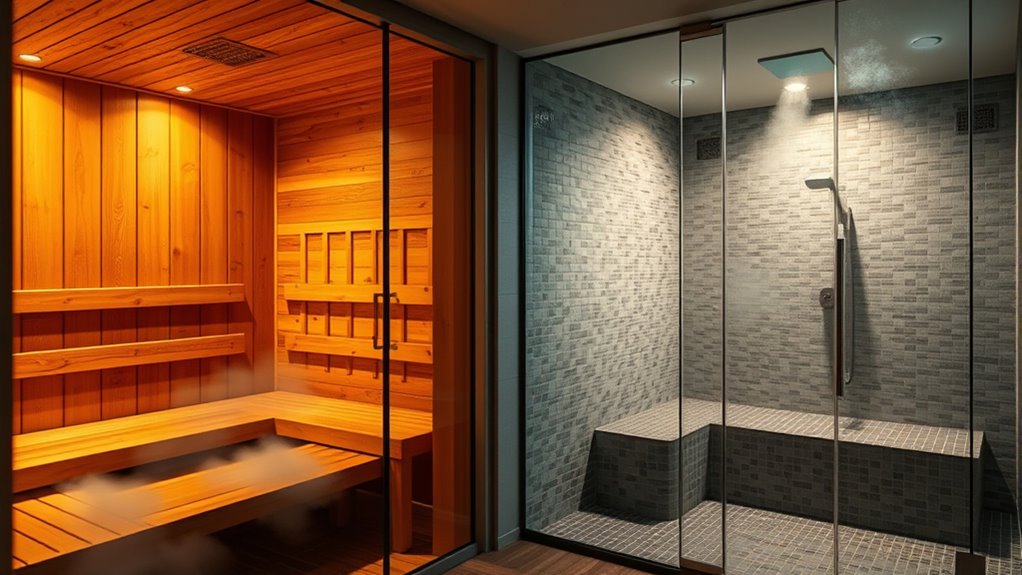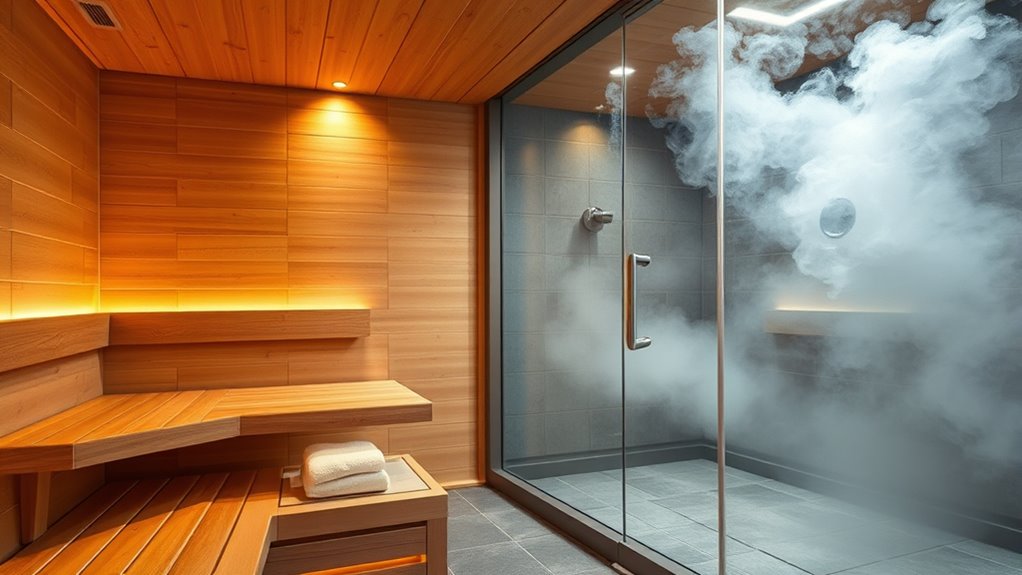Choosing between a sauna and steam room depends on your health goals. Saunas offer dry heat that boosts circulation, relaxes muscles, and supports heart health, while steam rooms provide moist heat that hydrates your skin and relieves respiratory issues. If you’re seeking detox and cardiovascular benefits, a sauna might suit you better. For respiratory relief and skin hydration, a steam room could be ideal. Keep exploring to discover which environment aligns best with your well-being needs.
Key Takeaways
- Saunas promote cardiovascular health, muscle relaxation, and skin elasticity through dry heat, while steam rooms enhance respiratory health and hydrate skin with moist heat.
- Regular sauna use (4–7 sessions/week) is linked to reduced mortality, stroke, and dementia risks; steam rooms have less robust but complementary health benefits.
- Saunas are better for detoxification and muscle recovery, whereas steam rooms are more effective for respiratory relief and skin hydration.
- Both environments increase circulation and core temperature, but saunas do so with dry heat, and steam rooms with humid heat.
- Combining sauna and steam room sessions can optimize overall health benefits, addressing both cardiovascular and respiratory wellness.

When choosing between a sauna and a steam room, understanding their differences can help you maximize health benefits and suit your preferences. A sauna offers dry heat, typically between 180 and 200°F (82–93°C), with low humidity. This environment causes you to sweat profusely, which aids in detoxification and pore cleansing. In contrast, a steam room provides wet heat at a lower temperature—around 110 to 120°F (43–49°C)—but with near 100% humidity created by visible steam. The moist environment feels heavier but offers distinct advantages, especially for respiratory health. Saunas can also improve skin elasticity and reduce stress levels through relaxation. If you prefer rapid muscle relief and quick sweating, a sauna is ideal. Its dry heat promotes faster muscle relaxation and reduces joint pain more effectively than a steam room. When it comes to respiratory benefits, a steam room’s humid air is particularly effective. It eases sinus congestion and makes breathing easier, providing immediate relief for those with respiratory issues or congestion. Both environments increase heart rate and circulation, with the core temperature rising faster in the steam room due to the high humidity, which enhances cardiovascular effects during your session. In the short term, a sauna helps with post-workout recovery by flushing out toxins through heavy sweating, while a steam room hydrates your skin and alleviates nasal and sinus congestion. The sauna’s intense sweating can also support cholesterol flushing, contributing to overall cardiovascular health. The steam room’s activation of heat shock proteins may reduce inflammation, and both environments help reduce stress and promote relaxation. Long-term health benefits are notable, especially with regular use. Research links sauna sessions—about four to seven times a week—to a 31% lower risk of mortality, 62% lower stroke risk, 66% lower dementia risk, and a 65% reduction in Alzheimer’s risk. Regular sauna use also lowers systolic and diastolic blood pressure, improves arterial stiffness, and supports cardiovascular health. While evidence for long-term benefits from steam rooms is less robust, they might still contribute positively, especially when combined with exercise. Combining both can amplify health outcomes, providing holistic physical and mental benefits. In terms of skin and respiratory health, a sauna cleanses pores through intense sweating, which may help some skin conditions. A steam room deeply hydrates skin and is beneficial for dermatological issues requiring moisture. For respiratory health, the moist air of a steam room offers quick relief for congestion and asthma symptoms, whereas a sauna provides moderate respiratory benefits. Both environments improve circulation to the skin, supporting overall skin health. When it comes to cardiovascular and metabolic effects, saunas have strong evidence supporting benefits like reduced heart attack and stroke risk, improved cholesterol, and weight support when paired with a healthy lifestyle. While steam rooms may not have as much direct evidence, their calming, hydrating effects still make them valuable components of wellness routines.
Frequently Asked Questions
Can Sauna or Steam Room Help With Muscle Recovery?
You’re wondering if a sauna or steam room can help with muscle recovery. Both can assist, but saunas are more effective at reducing soreness and improving flexibility, especially after intense workouts. They boost growth hormone levels and enhance circulation, speeding up recovery. Steam rooms offer some benefits, mainly for skin hydration and respiratory relief, but for muscle repair, a sauna, particularly infrared, is your best bet.
Are There Age Restrictions for Using Saunas or Steam Rooms?
Think of your body as a delicate garden that needs careful tending. Age restrictions act like the gardener’s guidelines, protecting young shoots from harsh conditions. You should know that most places don’t allow children under 3 or 12 in saunas or steam rooms. Younger kids need extra supervision, and sessions should be brief. Always adhere to facility rules and consult healthcare providers to guarantee safety for children and seniors alike.
How Do Sauna and Steam Room Benefits Differ for Skin Health?
You’ll notice that steam rooms hydrate your skin deeply, thanks to their 100% humidity, opening pores and locking in moisture. Saunas, with dry heat, help cleanse pores but can dry out your skin if you don’t moisturize afterward. For skin health, steam rooms boost hydration and detoxification, making your skin softer and clearer, especially if you have dry or sensitive skin. Both can improve skin clarity, but steam rooms offer more immediate moisture benefits.
Can These Heat Therapies Improve Mental Health or Reduce Stress?
Heat therapies like saunas and steam rooms can definitely improve your mental health and reduce stress. You’ll feel more relaxed and mindful as the heat promotes relaxation and lowers cortisol levels. Regular use can boost mood, improve sleep, and help you manage anxiety better. While saunas have more documented long-term benefits, both environments encourage mental well-being by providing a calming space to unwind and focus on self-care.
Are There Specific Health Conditions That Contraindicate Sauna or Steam Room Use?
You might think heat therapy is harmless, but some health conditions make it dangerous—like pregnancy, recent heart attacks, or severe heart issues. For saunas, avoid if you have unstable heart conditions or chest pain. Steam rooms aren’t safe if you’re immunocompromised, ill, or recovering from surgery. Always get medical clearance, stay hydrated, and limit your time to prevent heat-related risks. Your health’s worth more than a quick heat session.
Conclusion
Both saunas and steam rooms offer unique health benefits, so choosing one depends on your preferences and needs. If you enjoy dry heat, a sauna might boost your cardiovascular health more effectively, as studies show it can improve heart function by up to 30%. On the other hand, steam rooms can help with skin hydration and respiratory issues. Whichever you pick, regular sessions can enhance your overall well-being—so go ahead, indulge and reap the rewards.









